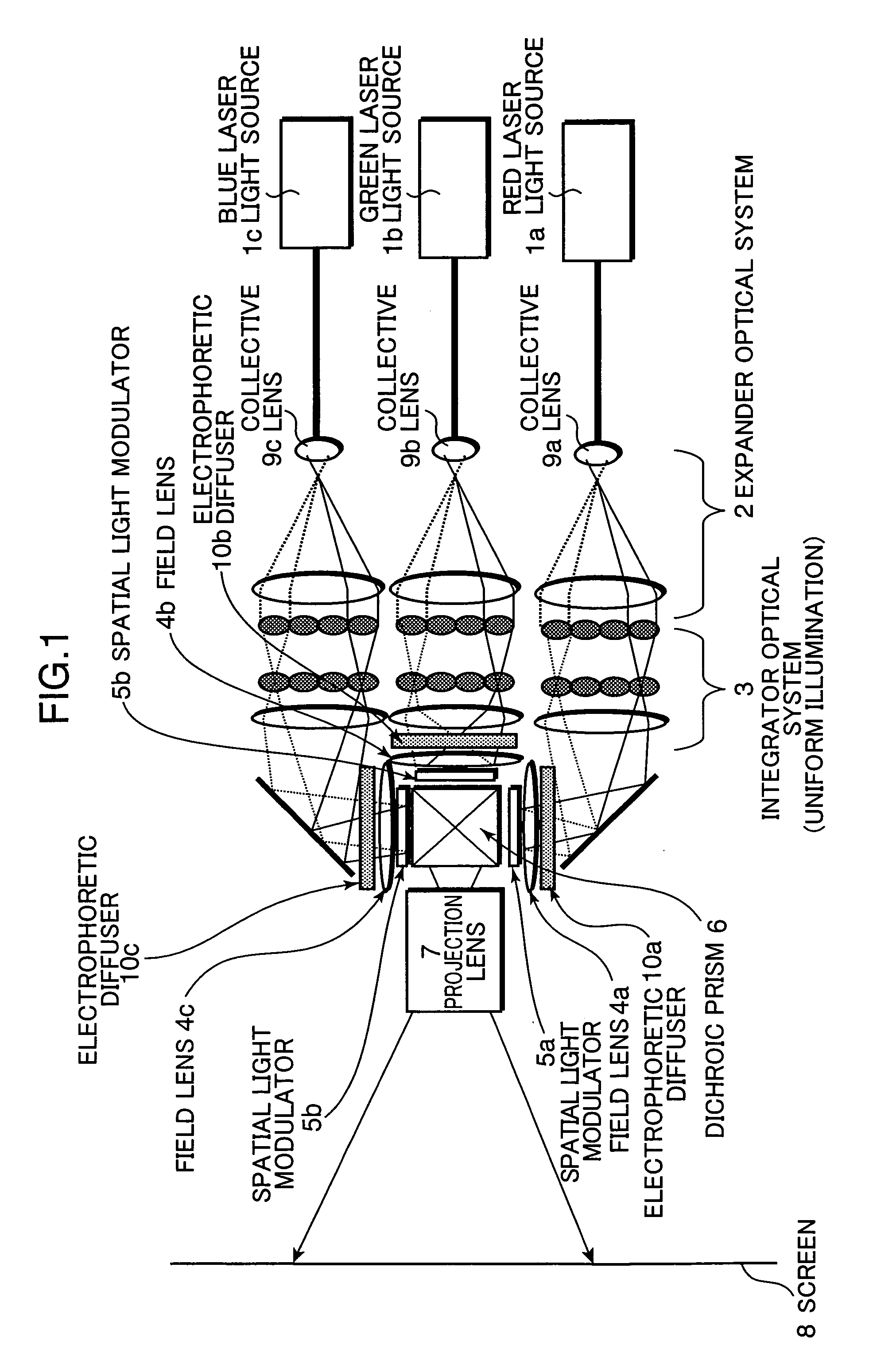Laser image display apparatus
a technology of image display and laser, which is applied in the direction of picture reproducers, picture reproducers using projection devices, instruments, etc., can solve the problems of reducing the image quality of an image due to irregularities, and reducing the accuracy of the imag
- Summary
- Abstract
- Description
- Claims
- Application Information
AI Technical Summary
Benefits of technology
Problems solved by technology
Method used
Image
Examples
embodiment 1
[0026]FIG. 1 shows a schematic diagram of a laser image display apparatus according to an embodiment of the present invention. Rays of light emitted from a red laser light source 1a, a green laser light source 1b, and a blue laser light source 1c are collected by collective lens 9a, 9b and 9c respectively. The collected rays of light are irradiated to electrophoretic diffusers (light diffusers) 10a, 10b, 10c respectively after being passed through an expander optical system 2 and an integrator optical system (illumination optical system) 3 and are beam-shaped to have a uniform light intensity distribution. The rays of light irradiated to the electrophoretic diffusers 10a, 10b, 10c are diffused by diffusing elements contained. therein. Consequently, directions of the rays of light after being passed through the electrophoretic diffuser 10a, 10b, 10c are diffused.
[0027] The rays of laser light diffused by the electrophoretic diffusers 10a, 10b, 10c are irradiated to spatial light mod...
embodiment 2
[0052] Further, according to another construction of a laser image display apparatus of the present invention, an electrophoretic diffuser 10 containing light diffusing elements is unified with a spatial light modulator 5 as shown in FIG. 4, and thereby a speckle noise is reduced and eliminated. Herein, the optical system such as the integrator optical system 3 and the like are omitted for simplicity. According to this construction, after the rays of light emitted from the light source having been passed through the expander optical system and the integrator optical system, rays of the light beam can be irradiated to the unified optical system including the electrophoretic diffuser 10 and the spatial light modulator 5 in a state of a uniform illumination light ray. Furthermore, as shown in FIG. 5, it can also be constructed so as to have a reflective spatial light modulator as a spatial light modulator. Here, LCOS (Liquid Crystal On Silicon), which is representative of all other ref...
embodiment 3
[0053] Further, according to another construction of a laser image display apparatus of the present invention, as shown in FIG. 6, a light diffuser containing light diffusing elements and a liquid crystal used in a two-dimensional spatial light modulator for projecting an image are contained in the same liquid. For example, it functions as a diffuser by moving the particles by heat, and, on the other hand, it functions as a two-dimensional light modulator by controlling a liquid crystal (a reflective liquid crystal is used in FIG. 6) by electricity.
[0054] Here, the same as in the embodiment 1, a distance between the diffuser and the light modulator needs to be set in an appropriate position to suppress the light amount loss and the luminosity irregularity to a minimum. Therefore, portions of a light diffusing function and a light modulating function needs to be separated, and the particles and the liquid crystal contained in the same liquid needs to be arranged in an appropriate po...
PUM
 Login to View More
Login to View More Abstract
Description
Claims
Application Information
 Login to View More
Login to View More - R&D
- Intellectual Property
- Life Sciences
- Materials
- Tech Scout
- Unparalleled Data Quality
- Higher Quality Content
- 60% Fewer Hallucinations
Browse by: Latest US Patents, China's latest patents, Technical Efficacy Thesaurus, Application Domain, Technology Topic, Popular Technical Reports.
© 2025 PatSnap. All rights reserved.Legal|Privacy policy|Modern Slavery Act Transparency Statement|Sitemap|About US| Contact US: help@patsnap.com



